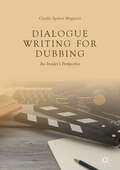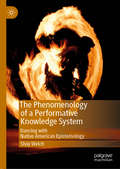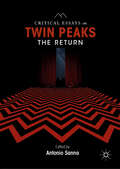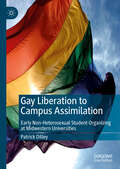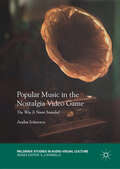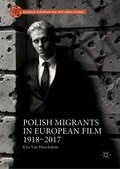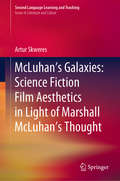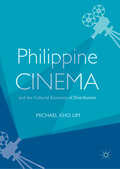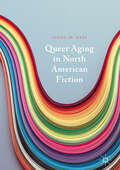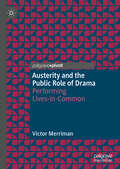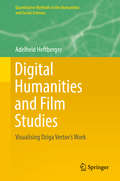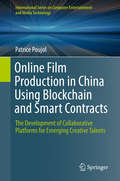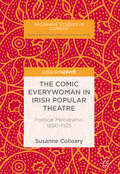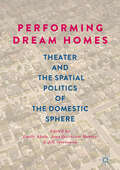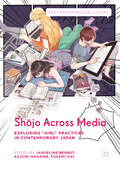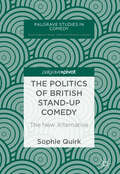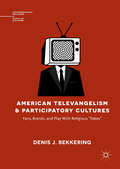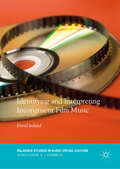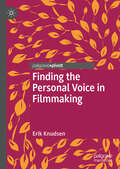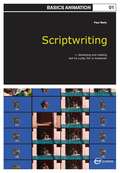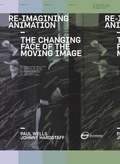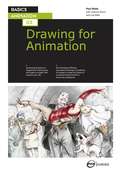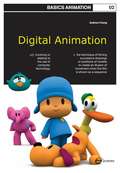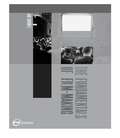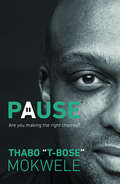- Table View
- List View
Dialogue Writing for Dubbing: An Insider's Perspective
by Giselle Spiteri MiggianiThis book analyses an important phase in the interlingual dubbing process of audiovisual productions: the elaboration of target language scripts for the recording studios. Written by a practitioner in the industry who is also an academic and trainer, it provides practical know-how and guidelines while adopting a scholarly, structural and methodical approach. Supported by an exemplified, analytical and theoretical framework, it is non-language specific and discusses strategies and tricks of the trade. Divided into three parts, the book provides a descriptive, practical and analytical approach to dubbing and dialogue writing. The author analyses scripts drawn from her own professional practice, including initial drafts that illustrate the various transformations of a text throughout the rewriting process. She also offers a ‘backstage’ perspective, from first-hand experience in recording sessions that enabled knowledge of text manipulation, studio jargon, and the dubbing post production process. This publication will provide a valuable resource for novice dubbing translators and dialogue writers, while offering practitioner insights to scholars and researchers in the field of Audiovisual Translation, Film and Media Studies.
The Phenomenology of a Performative Knowledge System: Dancing with Native American Epistemology (Performance Philosophy Ser.)
by Shay WelchThis book investigates the phenomenological ways that dance choreographing and dance performance exemplify both Truth and meaning-making within Native American epistemology, from an analytic philosophical perspective. Given that within Native American communities dance is regarded both as an integral cultural conduit and “a doorway to a powerful wisdom,” Shay Welch argues that dance and dancing can both create and communicate knowledge. She explains that dance—as a form of oral, narrative storytelling—has the power to communicate knowledge of beliefs and histories, and that dance is a form of embodied narrative storytelling. Welch provides analytic clarity on how this happens, what conditions are required for it to succeed, and how dance can satisfy the relational and ethical facets of Native epistemology.
Critical Essays on Twin Peaks: The Return
by Antonio SannaThis edited collection offers an interdisciplinary study of Twin Peaks: The Return, the third season of a TV program that has attracted the attention (and appreciation) of spectators, fans, and critics for over two decades. The book takes readers into several distinct areas and addresses the different approaches and the range of topics invited by the multidimensionality of the subject itself: the philosophical, the artistic, the socio-cultural, and the personal. The eighteen chapters constituting the volume are academic in their approach to the subject and in their methodology, whether they apply a historical, psychoanalytical, film studies, or gender studies perspective to the text under examination. The variety and range of perspectives in these aforementioned chapters reflect the belief that a study of the full complexity of Twin Peaks: The Return, as well as a timely assessment of the critical importance of the program, requires both an interdisciplinary perspective and the fusion of different intellectual approaches across genres. The chapters demonstrate a collective awareness of the TV series as a fundamental milestone in contemporary culture.
Gay Liberation to Campus Assimilation: Early Non-Heterosexual Student Organizing at Midwestern Universities
by Patrick DilleyAssociation for the Study of Higher Education Outstanding Book Award Winner, 2020This book outlines the beginning of student organizing around issues of sexual orientation at Midwestern universities from 1969 to the early 1990s. Collegiate organizations were vitally important to establishing a public presence as well as a social consciousness in the last quarter of the twentieth century. During this time, lesbian and gay students struggled for recognition on campuses while forging a community that vacillated between fitting into campus life and deconstructing the sexist and heterosexist constructs upon which campus life rested. The first openly gay and lesbian student body presidents in the United States were elected during this time period, at Midwestern universities; at the same time, pioneering non-heterosexual students faced criticism, condemnation, and violence on campus. Drawing upon interviews, extensive reviews of campus newspapers and yearbooks, and archival research across the Midwest, Patrick Dilley demonstrates how the early gay campus groups created and provided educational and support services on campus–efforts that later became incorporated into campus services across the nation. Further, the book shows the transformation of gay identity into a minority identity on campus, including the effect of alliances with campus racial minorities.
Popular Music in the Nostalgia Video Game: The Way It Never Sounded (Palgrave Studies in Audio-Visual Culture)
by Andra IvănescuThis book looks at the uses of popular music in the newly-redefined category of the nostalgia game, exploring the relationship between video games, popular music, nostalgia, and socio-cultural contexts. History, gender, race, and media all make significant appearances in this interdisciplinary work, as it explores what some of the most critically acclaimed games of the past two decades (including both AAA titles like Fallout and BioShock, and more cult releases like Gone Home and Evoland) tell us about our relationship to our past and our future. Appropriated music is the common thread throughout these chapters, engaging these broader discourses in heterogeneous ways. This volume offers new perspectives on how the intersection between popular music, nostalgia, and video games, can be examined, revealing much about our relationship to the past and our hopes for the future.
Polish Migrants in European Film 1918–2017 (Palgrave European Film and Media Studies)
by Kris Van HeuckelomThis study explores the representation of international migration on screen and how it has gained prominence and salience in European filmmaking over the past 100 years. Using Polish migration as a key example due to its long-standing cultural resonance across the continent, this book moves beyond a director-oriented approach and beyond the dominant focus on postcolonial migrant cinemas. It succeeds in being both transnational and longitudinal by including a diverse corpus of more than 150 films from some twenty different countries, of which Roman Polański’s The Tenant, Jean-Luc Godard’s Passion and Krzysztof Kieślowski’s Trois couleurs: Blanc are the best-known examples. Engaging with contemporary debates on modernisation and Europeanisation, the author proposes the notion of “close Otherness” to delineate the liminal position of fictional characters with a Polish background. Polish Migrants in European Film 1918-2017 takes the reader through a wide range of genres, from interwar musicals to Cold War defection films; from communist-era exile right up to the contemporary moment. It is suitable for scholars interested in European or Slavic studies, as well as anyone who is interested in topics such as identity construction, ethnic representation, East-West cultural exchanges and transnationalism.
McLuhan’s Galaxies: Science Fiction Film Aesthetics in Light of Marshall McLuhan’s Thought (Second Language Learning and Teaching)
by Artur SkweresThis groundbreaking book uses observations made by Marshall McLuhan to analyze the aesthetics of science fiction films, treating them as visual metaphors or probes into the new reality dominated by electronic media: - it considers the relations between the senses and sensuality in Blade Runner, the visually-tactile character of the film, and the status of replicants as humanity’s new clothes; - it analyzes the mixture of Eastern and Western aesthetics in Star Wars, analyzing Darth Vader as a combination of the literate and the tribal mindset; - it discusses the failure of visual society presented in the Terminator and Alien franchises, the rekindling of horror vacui, tribalism, and the desire to obliterate the past as a result of the simultaneity of the acoustic space; - finally, the book discusses the Matrix trilogy and Avatar as being deeply related in terms of the growing importance of tactility, easternization, tribalization, as well as connectivity and the implosion of human civilization.
Philippine Cinema and the Cultural Economy of Distribution
by Michael Kho LimThis book explores the complex interplay of culture and economics in the context of Philippine cinema. It delves into the tension, interaction, and shifting movements between mainstream and independent filmmaking, examines the film distribution and exhibition systems, and investigates how existing business practices affect the sustainability of the independent sector. This book addresses the lack or absence of Asian representation in film distribution literature by supplying the much-needed Asian context and case study. It also advances the discourse of film distribution economy by expounding on the formal and semi-formal film distribution practices in a developing Asian country like the Philippines, where the thriving piracy culture is considered as ‘normal,’ and which is commonly depicted and discussed in existing literature. As such, this will be the first book that looks into the specifics of the Philippine film distribution and exhibition system and provides a historical grounding of its practices.
Queer Aging in North American Fiction
by Linda M. HessExploring representations of queer aging in North American fiction, this book illuminates a rich yet previously unheeded intersection within American culture. At a time when older LGBTQ persons gradually gain visibility in gerontological studies and in the media, this work provides a critical perspective concerned with the ways in which the narratives and images we have at our disposal shape our realities. Each chapter shines a spotlight on a significant work of queer fiction, beginning with post-WWII novels and ending with filmic representations of the 2010s, exploring narratives as both reflections and agents of broader cultural negotiations concerning queer sexuality and aging. As a result, the book not only redresses queer aging’s history of invisibility, but also reveals narratives of queer aging to be particularly apt in casting new light on the ways in which growing older is perceived and conceptualized in North American culture.
Austerity and the Public Role of Drama: Performing Lives-in-Common
by Victor MerrimanThis book asks what, if any, public role drama might play under Project Austerity – an intensification phase of contemporary liberal political economy. It investigates the erosion of public life in liberal democracies, and critiques the attention economy of deficit culture, by which austerity erodes life-in-common in favour of narcissistic performances of life-in-public. It argues for a social order committed to human flourishing and deliberative democracy, as a counterweight to the political economy of austerity. It demonstrates, using examples from England, Ireland, Italy, and the USA, that drama and the academy pursue shared humane concerns; the one, a critical art form, the other, a social enabler of critical thought and progressive ideas. A need for dialogue with emergent forms of collective consciousness, new democratic practices and institutions, shapes a manifesto for critical performance, which invites universities and cultural workers to join other social actors in imagining and enabling ethical lives-in-common.
Digital Humanities and Film Studies: Visualising Dziga Vertov's Work (Quantitative Methods in the Humanities and Social Sciences)
by Adelheid HeftbergerThis book highlights the quantitative methods of data mining and information visualization and explores their use in relation to the films and writings of the Russian director, Dziga Vertov. The theoretical basis of the work harkens back to the time when a group of Russian artists and scholars, known as the “formalists,” developed new concepts of how art could be studied and measured. This book brings those ideas to the digital age. One of the central questions the book intends to address is, “How can hypothetical notions in film studies be supported or falsified using empirical data and statistical tools?” The first stage involves manual and computer-assisted annotation of the films, leading to the production of empirical data which is then used for statistical analysis but more importantly for the development of visualizations. Studies of this type furthermore shed light on the field of visual presentation of time-based processes; an area which has its origin in the Russian formalist sphere of the 1920s and which has recently gained new relevance due to technological advances and new possibilities for computer-assisted analysis of large and complex data sets. In order to reach a profound understanding of Vertov and his films, the manual or computer-assisted data analysis must be combined with film-historical knowledge and a study of primary sources. In addition, the status of the surviving film materials and the precise analysis of these materials combined with knowledge of historical film technology provide insight into archival policy and political culture in the Soviet Union in the 1920s and 30s.
Online Film Production in China Using Blockchain and Smart Contracts: The Development of Collaborative Platforms for Emerging Creative Talents (International Series on Computer Entertainment and Media Technology)
by Patrice PoujolThis book explores the use of Blockchain and smart contract technologies to develop new ways to finance independent films and digital media worldwide. Using case studies of Alibaba and in-depth, on-set observation of a Sino-US coproduction, as well as research collected from urban China, Hong Kong, Europe, and the USA, Online Film Production in China Using Blockchain and Smart Contracts explores new digital platforms and what this means for the international production of creative works. This research assesses the change in media consciousness from young urban audiences, their emergence as a potential participative and creative community within dis-intermediated, decentralised and distributed crowdfunding and crowdsourcing models. This research proposes solutions on how these young emerging local creative talents can be identified and nurtured early on, particularly those who now produce creative and artistic audiovisual content whether these works are related to film, Virtual Reality (VR), video game, graphic novels, or music. Ultimately, a new media content finance and production platform implementing blockchain is proposed to bring transparency in the film sector and open doors to emerging artists in digital media. Appropriate for both professionals and academics in the film industry as well as computer science.
The Comic Everywoman in Irish Popular Theatre: Political Melodrama, 1890-1925 (Palgrave Studies in Comedy)
by Susanne CollearyThis book is a comprehensive study of comic women in performance as Irish Political Melodrama from 1890 to 1925. It maps out the performance contexts of the period, such as Irish “poor” theatre both reflecting and complicating narratives of Irish Identity under British Rule. The study investigates the melodramatic aesthetic within these contexts and goes on to analyse a selection of the melodramas by the playwrights J.W. Whitbread and P.J. Bourke. In doing so, the analyses makes plain the comic structures and intent that work across both character and action, foregrounding comic women at the centre of the discussion. Finally, the book applies a “practice as research” dimension to the study. Working through a series of workshops, rehearsals and a final performance, Colleary investigates comic identity and female performance through a feminist revisionist lens. She ultimately argues that the formulation of the Comic Everywoman as staged “Comic” identity can connect beyond the theatre to her “Everyday” self. This book is intended for those interested in theatre histories, comic women and in popular performance.
Performing Dream Homes: Theater and the Spatial Politics of the Domestic Sphere
by Emily Klein Jennifer-Scott Mobley Jill StevensonThis anthology explores how theatre and performance use home as the prism through which we reconcile shifts in national, cultural, and personal identity. Whether examining parlor dramas and kitchen sink realism, site-specific theatre, travelling tent shows, domestic labor, border performances, fences, or front yards, these essays demonstrate how dreams of home are enmeshed with notions of neighborhood, community, politics, and memory. Recognizing the family home as a symbolic space that extends far beyond its walls, the nine contributors to this collection study diverse English-language performances from the US, Ireland, and Canada. These scholars of theatre history, dramaturgy, performance, cultural studies, feminist and gender studies, and critical race studies also consider the value of home at a time increasingly defined by crises of homelessness — a moment when major cities face affordable housing shortages, when debates about homeland and citizenship have dominated international elections, and when conflicts and natural disasters have displaced millions. Global struggles over immigration, sanctuary, refugee status and migrant labor make the stakes of home and homelessness ever more urgent and visible, as this timely collection reveals.
Shōjo Across Media: Exploring "Girl" Practices in Contemporary Japan (East Asian Popular Culture)
by Jaqueline Berndt Kazumi Nagaike Fusami OgiSince the 2000s, the Japanese word shōjo has gained global currency, accompanying the transcultural spread of other popular Japanese media such as manga and anime. The term refers to both a character type specifically, as well as commercial genres marketed to female audiences more generally. Through its diverse chapters this edited collection introduces the two main currents of shōjo research: on the one hand, historical investigations of Japan’s modern girl culture and its representations, informed by Japanese-studies and gender-studies concerns; on the other hand, explorations of the transcultural performativity of shōjo as a crafted concept and affect-prone code, shaped by media studies, genre theory, and fan-culture research. While acknowledging that shōjo has mediated multiple discourses throughout the twentieth century—discourses on Japan and its modernity, consumption and consumerism, non-hegemonic gender, and also technology—this volume shifts the focus to shōjo mediations, stretching from media by and for actual girls, to shōjo as media. As a result, the Japan-derived concept, while still situated, begins to offer possibilities for broader conceptualizations of girlness within the contemporary global digital mediascape.
The Politics of British Stand-up Comedy: The New Alternative (Palgrave Studies in Comedy)
by Sophie QuirkThis Palgrave Pivot questions how a new generation of alternative stand-up comedians and the political world continue to shape and influence each other. The Alternative Comedy Movement of the late 1970s and 1980s can be described as a time of unruly experimentation and left-wing radicalism. This book examines how alternative comedians continue to celebrate these characteristics in the twenty-first century, while also moving into a distinct phase of artistic development as the political context of the 1970s and 1980s loses its immediacy. Sophie Quirk draws on original interviews with comedians including Tom Allen, Josie Long, John-Luke Roberts and Tony Law to chart how alternative comedians are shaped by, and in turn respond to, contemporary political challenges from neoliberalism to Brexit, class controversy to commercialism. She argues that many of our assumptions about comedy’s politics must be challenged and updated. This book is essential reading for anyone who wants to understand the working methods and values of today’s alternative comedians.
American Televangelism and Participatory Cultures: Fans, Brands, and Play With Religious "Fakes" (Contemporary Religion and Popular Culture)
by Denis J. BekkeringThis book examines unintended participatory cultures and media surrounding the American televangelists Robert Tilton and Tammy Faye Bakker-Messner. It brings to light heavily ironic fan followings; print, audio, and video projects; public access television parodies; and other comedic participatory practices associated with these controversial preachers from the 1980s onwards. For Tilton’s ministry, some of these activities and artifacts would prove irksome and even threatening, particularly an analog video remix turned online viral sensation. In contrast, Bakker-Messner’s “campy” fans – gay men attracted to her “ludicrous tragedy” – would provide her unexpected opportunities for career rehabilitation. Denis J. Bekkering challenges “supply-side” religious economy and branding approaches, suggestions of novelty in religion and “new” media studies, and the emphasis on sincere devotion in research on religion and fandom. He also highlights how everyday individuals have long participated in public negotiations of Christian authenticity through tongue-in-cheek play with purported religious “fakes.”
Identifying and Interpreting Incongruent Film Music (Palgrave Studies in Audio-Visual Culture)
by David IrelandThis book explores the concept of incongruent film music, challenging the idea that this label only describes music that is inappropriate or misfitting for a film’s images and narrative. Defining incongruence as a lack of shared properties in the audiovisual relationship, this study examines various types of incongruence between a film and its music and considers the active role that it can play in the construction of a film’s meaning and influencing audience response. Synthesising findings from research in the psychology of music in multimedia, as well as from ideas sourced in semiotics, film music, and poststructuralist theory, this interdisciplinary book provides a holistic perspective that reflects the complexity of moments of film-music incongruence. With case studies including well-known films such as Gladiator and The Shawshank Redemption, this book combines scene analysis and empirical audience reception tests to emphasise the subjectivity, context-dependency, and multi-dimensionality inherent in identifying and interpreting incongruent film music.
Finding the Personal Voice in Filmmaking
by Erik KnudsenThis book philosophically and creatively examines ways in which independent filmmakers may explore, through practice, the discovery and development of a personal voice in the making of their films. Filmmaker and academic, Professor Erik Knudsen, uses a combination of autoethnographic experience derived from his own filmmaking practice and new insights gained from a series of ethnomediaological StoryLab workshops with independent filmmakers in Malaysia, Ghana and Colombia to drive this innovative examination. The book contextualises this practice exploration within an eclectic psychological and philosophical framework that ranges from Jungian psychological theories of the collective unconscious to Sheldrakian scientific theories of morphic resonance, from Christian mystical ideas about creative motivation to structuralist theories that underpin our linguistic understanding of story and narrative. Why should we create? What is a creative act? This in-depth study tackles these questions by examining the early ideation stages of cinematic expression and ultimately seeks to understand the practical ways in which ideas are shaped into stories and narratives.
Basics Animation 01: Scriptwriting (Basics Animation)
by Paul WellsBasics Animation: Scriptwriting addresses the full range of approaches to scripting and developing for animated films.It details the issues faced by the animation scriptwriter, and the techniques to overcome them. It also seeks to promote the unique qualities of animation as a form of expression, using many images to illustrate and emphasise points made in the text.This book looks at genres in animation as a starting point for scripting, employing a range of case studies from feature films to public relations work to independent productions, in order to reveal a range of approaches to writing.
Re-Imagining Animation: The Changing Face Of The Moving Image (Required Reading Range)
by Paul Wells Johnny HardstaffRe-Imagining Animation: The Changing Face of the Moving Image by Paul Wells and Johnny Hardstaff explores the changing nature of animation in the twenty-first century.Animation was once constructed frame-by-frame, but now the creation and manipulation of the moving image has changed. With the digital revolution, what was once merely an adjunct of film has become central to the entire cinematic enterprise. This title examines animation's changing role through engagement with a series of contemporary moving-image works, and comprises an important text on a popular subject.Each case study looks at the entire creative process, from the initial creative stimulus, through the development of an aesthetic and the technical production of the work, to the final outcome.This book is suitable for students of animation, established professional animators, and anyone with an interest in animation.
Basics Animation 03: Drawing for Animation (Basics Animation #3)
by Paul WellsBasics Animation 03: Drawing for Animation introduces readers to the practice of drawing images for use in animation. It examines the thinking process and techniques involved with drawing characters, composition and movement, narrative and adaptation.Drawing is a fundamental part of the preparatory stages of virtually all design-led projects. It is the core method by which ideas and concepts are envisaged and ultimately shared with collaborators, clients and audiences.Aimed at students and those interested in entering the animation business, this book explores the pre-production work essential for producing great animation. It gives readers a real insight into this work through its outstanding range of images.
Digital Animation (Basics Animation #2)
by Andrew ChongBasics Animation 02: Digital Animation takes a comprehensive look at the history of the medium, its growth and development over the last 50 years.This book features exciting contributions from innovators and pioneers in the medium as well as present day practitioners in the cinema, game, and television industries.
The Fundamentals of Film Making (Fundamentals)
by Jane BarnwellThe Fundamentals of Film-Making provides an overview of the collaborative process of film-making.The book maps out the practical, technical and creative aspects involved, sets out the division of labour, and explains how each individual role combines to influence the final piece. The three primary stages of film production – pre-production, production and post-production – are covered through chapters dealing with each of the major departments: script; production; direction; production design; cinematography; sound and post-production.The book concludes with an examination of film analysis, providing context and connections between film theory and practice.
Pause: Are you making the right choices?
by Thabo T-Bose MokweleWhen we learn from each other, that’s when we learn more about ourselves.With a radio career spanning more than three decades, Thabo T-Bose Mokwele brings topics to the airwaves that challenge and invoke human introspection and dialogue with his audience. And through this he has learned a lot about life and its nuances. Pause is a collection of Thabo’s observations, reflections and learnings about what life is about. Simply put, this is the book he wishes he had read before starting his adult life journey.Pause is a compilation of Thabo's pearls of wisdom and lessons about life, God, money, relationships, parenting and, most importantly, self-mastery. His knowledge has been acquired by reading other philosophers' views on life and love, from interviewing entrepreneurs and entertainers about self-sufficiency, and preachers and teachers about self-mastery. This, you may say, is his ‘bible’, to drive his life, and a lens through which he views his existence.Thabo shares what he knows, what he practises and what still challenges him. It’s a book that everyone, from teens to adults, should read for a glimpse, and as a guide, to living a life that is meaningful.We learn from our mistakes, but some mistakes are costly and should never be repeated. And if reading a short chapter on a particular topic can help mould a young person’s life, or assist an adult to self-correct, then Pause is a must-read.Thabo says: We all need to learn, unlearn and relearn many things in order to fully realise who we are meant to be.
